BINARY CHOICE QUESTIONS (14 QUESTIONS)
Question 1: Consider the market for Idaho potatoes. The supply is very inelastic in the short run since farmers in Idaho cannot increase or decreasethe supply of potatoes in the fall since the supply depends on how many seed potatoes they put in the ground in March.The demand for Idaho potatoes is relative elastic as consumers have alternative options like potatoes from Washington State. Given this information, if the government levies an excise tax on Idaho potato farmers, who will bear more of the economic tax burden?
a) Potato farmers in Idaho
b) Consumers of Idaho potatoes
Question 2: Juanplans to spend $150 on Chelsea Heritage soccer balls and Jose Mourinhoposters as Thanksgiving gifts to his wife. The price of one Chelsea Heritage soccer ball is $25 and the price of one Jose Mourinhoposter is $12. Suppose the price of Chelsea Heritage soccer balls and Jose Mourinhopostersdecrease by 25% respectively. At the same time, Juan’sbudget for Thanksgiving gifts to his wifeincreases by 50%. As a result, Juan’s budget constraint makes a
a) parallel shift to the right of his initial budget line
b) parallel shift to the left of his initial budget line
Question 3: Suppose Trimalchio has a demand curve for peahen eggs as follows where P is the price per peahen egg and Q is the quantity of peahen eggs:
P = 100 - 10Q
If the price of a peahen egg is $25, is Trimalchio's demand for peahen eggs relatively elastic or inelastic?
a) Inelastic
b) Elastic
Question 4: Mexico exports Crude Petroleum to the rest of the world. If international trade were banned, the price of Crude Petroleum in Mexico would be _____ the world price of Crude Petroleum, and Mexican domestic consumers _____.
a) higher than; would be worse off
b) lower than; would be better off
Question 5: If goods x and y have negative cross price elasticities of demand, how do goods x and y relate to one another?
a) They are complements.
b) They are substitutes.
Question 6: Bob gets 10 utils of benefit from consumption of 1 apple and 20 utils from consumption of 1 banana. If we conclude Bob is twice as well off consuming 1 banana than he is consuming 1 apple, we must be assuming Bob's utility map is measured using
a) Cardinal utility.
b) Ordinal utility.
Question 7: True or False: if the average cost function is downward sloping for a certain range of quantities, then the marginal cost curve must be downward sloping over that range of quantities.
a) True
b) False
Question 8: You have been given information about the cost of a typical consumption basket in the years 1990, 2000 and 2010 in Japan. The currency used in Japan are yen. The cost of the basket in Japan went down between 1990 and 2000 and also went down between 2000 and 2010. Then if we use 2000 as the base year,
a) Real prices (in year 2000 yen) in 1990 will be lower than nominal prices in 1990.
b) Real prices (in year 2000 yen) in 1990 will be higher than nominal prices in 1990.
Question 9: If the demand curve of a good is perfectly inelastic, and an excise tax is placed on it, which of the following is true?
a) Consumer Tax Incidence = $0
b) Producer Tax Incidence = $0
Question 10: In the following graph, each of the four straight lines represents a budget constraint under different prices and/or income levels. Each of the budget lines has a point A, B, C, or D on it. These points represent Tom’s utility maximizing choice for the given budget line.
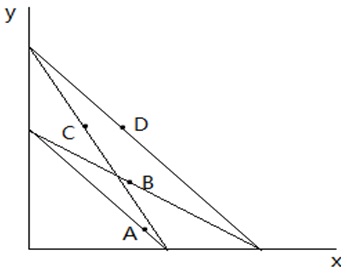
For which good is Tom’s income elasticity positive?
a) Good x
b) Good y
Question 11: Which of the following statements is not an assumption of perfect competition?
a) The market price is affected when a single firm in the market changes its market strategy.
b) The number of firms in the market is very large.
Question 12: The following two tables show income data for chemists, but one of the tables has a problem. Which table must be incorrect?
Table A
10th Percentile Income Median Income 90th Percentile Income
Chemist $45,000 $49,000 $91,000
Table B
10th Percentile Income Median Income 90th Percentile Income
Chemist $104,000 $94,000 $56,000
a) Table A
b) Table B
Question 13: Suppose in an open market, the nation of Someplace would import 50 widgets. Suppose the government of Someplace is considering imposing an import quota in this market: the government would like to impose an import quota of either 10 imports or 20 imports. The government of Someplace plans to choose the import quota that results in the smaller deadweight loss holding everything else constant. Should the government impose an import quota of 10 units or an import quota of 20 units given this goal?
a) The government of Someplace should impose the import quota of 10 imports.
b) The government of Someplace should impose the import quota of 20 imports.
Question 14: Country X only produces two goods: 100 guns and 200 roses each year. In 2000, the price of each gun was$5, and the price of each rose was$1. In 2010, the prices of guns and roseswere$4.5 and $3.5 respectively. If average prices in Country X as measured by the CPIincreased 20% from 2000 to 2010, then the real value of the Country X’s production of 100 guns and 200 roses has _________ from 2000 to 2010.
a) Increased
b) Decreased
MULTIPLE CHOICE QUESTIONS (20 QUESTIONS)
Use the following information to answer the next Three (3) questions:
Suppose the market demand for Cabernet Sauvignon (a type of red wine) from Napa Valley, California is given by the following equations where P is the price per bottle of wine and Q is the quantity of bottles of wine:
Demand: P = 300 – Q
Supply: P = (1/2)Q
In this market, suppose the government is going to implement an excise tax. Suppose the goal of the government with this excise tax is to limit consumption of Cabernet Sauvignon to 190 bottles of wine.
Question 15: How big will the excise tax per bottle need to be in order for the government to reach this consumption goal?
a) $ 10 per bottle
b) $ 15 per bottle
c) $ 20 per bottle
d) $ 25 per bottle
Question 16: Given the above information, what is the reduction in producer surplus due to the imposition of this excise tax?
a) $925
b) $950
c) $975
d) $1000
Question 17: What is the deadweight loss caused by the imposition of this excise tax?
a) $60
b) $65
c) $70
d) $75
Question 18: Which of the following effects occur with import tariffs, but not with excise taxes? Assume that any demand curve or supply curve in this question follows the Law of Demand or the Law of Supply, respectively.
a) The reallocation of some production to less efficient producers.
b) A reduction in consumer surplus resulting from higher domestic prices.
c) The collection of government revenue.
d) A change in the quantity of goods sold.
Use the following information to answer the next Two (2) questions:
Fu Chan is a poor graduate student. She earns a stipend of only $1500 every month out of which she has to spend $900 on housing. She plans to spend the rest of her stipend on dining. If she only dines in Liz Waters or Gordon Commons and spends all of her remaining stipend, then she can have either 120 meals in Liz Waters or 75 meals in Gordon Commons, respectively. Assume that the price of a meal in Liz Waters is constant and that the price of a meal in Gordon Commons is also constant.
Question 19: Given the above information, what is the price of one meal in Gordon Commons?
a) $5
b) $ 7
c) $ 8
d) $ 10
Question 20: If Fu’s utility function is given by U = L + (5/3)G where L stands for meals in Liz Waters and G stands for meals in Gordon Commons, which of the following affordable bundles (L, G) will maximize her utility?
a. (L = 20, G = 50)
b. (L = 120, G = 0)
c. (L = 40, G = 50)
d. (L = 0, G = 75)
Question 21: Suppose you are a producer of some good trying to determine whether to raise the price of your good. You know that at the current price, demand is inelastic. Which of the following is an accurate description of the price and quantity effects to your revenue if you raise the price?
a. Both the price effect and the quantity effect are positive.
b. Both the price effect and the quantity effect are negative.
c. The price effect is negative and the quantity effect is positive.
d. The price effect is positive and the quantity effect is negative.
Question 22: Given the following total cost equation, what is the fixed cost for the firm?
TC=(Q+1/Q^2 +4/Q^3 +5) Q^3
a) $1
b) $3
c) $4
d) $5
Use the following information for the next Two (2) questions:
This table shows a list of movies, the year that they were released, and their nominal total revenue in that year’s dollars.
Movie Title Year Nominal Total Revenue (in million $)
The Smell of Music 1980 200
The Godmother 1990 240
Jack Potter and Gluttonous Hallows 2000 300
Copper Man 3 2010 320
Suppose that the price level increased by 20 percent every decade (10 years).
Question 23: Suppose Professor Kelly bought a videotape of the movie “The Smell of Music” in 1980 for $10. In 1990, she sold this videotape for $30. What is the percentage change in the videotape’s real price (using 1980 as the base year)?
a) 100%
b) 150%
c) 200%
d) 250%
Question 24: After adjusting for inflation, which of the four movies listed had the highest total revenue in real dollars?
a) The Smell of Music
b) The Godmother
c) Jack Potter and Gluttonous Hallows
d) Copper Man 3
Question 25: Based on the following cost curve graph, what are fixed costs?
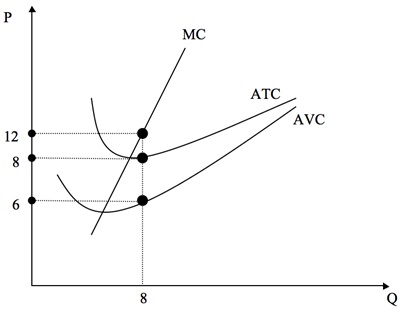
a. $2
b. $4
c. $16
d. $32
Use the following information for the next Two (2) questions:
Consider a small economy where the domestic demand and domestic supply curves for some good are given by the following equations where P is the price per unit of the good and Q is the number of units of the good.
Domestic Demand: P = 20 - Q for 0 ≤ Q ≤ 20
Domestic Supply: P = 2Q + 5 for Q ≥ 0
You also know that the world price of this good is $9.
Question 26. Holding everything else constant, if the government of this small economy institutes a tariff of $2 per unit, what will be the government revenue in this small economy from this policy?
a. $6
b. $12
c. $18
d. $22
Question 27. Suppose the government increases the tariff to $7 per unit imported. Compared to the $2 tariff, what is thechange in total surplus in this small economy? (When calculating total surplus, remember to include the surplus the domestic consumer gets, the surplus the domestic producer gets, and any revenue the government earns.)
a. No change
b. -$12
c. -$24
d. -$40.50
Question 28. If the U.S. government imposes a stricter quota policy (fewer quota licenses are granted) on imported cars, which of the following statements is FALSE?
a. The direction of the change in government revenue from selling the quota licenses is uncertain.
b. The direction of the change in deadweight loss caused by the stricter quota policy is uncertain.
c. The quantity of imported cars decreases.
d. The equilibrium price for cars in the U.S. increases with the stricter quota policy.
Question 29. The following cost curve graph is for a representative firm in a perfectly competitive industry:
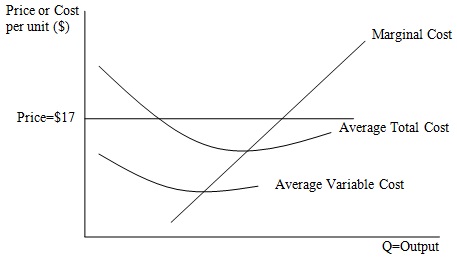
If the current market price for the good is $17, which of the following statements about the long run is true?
a) More firms will enter this industry, which will lead to an increase in the market supply of the good and a fall in the equilibrium price of the good.
b) More firms will enter this industry, which will eventually lead to a rise in the equilibrium price of the good.
c) Some firms will exit this industry leading to a decrease in the market supply of the good and a rise in the equilibrium price of the good.
d) Some firms will exit this industry, which will eventually lead to a fall in the equilibrium price of the good.
Question 30. Book printers are businesses that produce books. Suppose the market for book printers producing Paul Krugman’s textbook is perfectly competitive. You are given the following information:
- Average Total Cost for each printer is minimized at $100 per book.
- The marginal cost for each printer is given by the equation MC = 2q
- The market demand for these textbooks is perfectly inelastic at Q = 5000
Given this information and holding everything else constant, how many printers will be in this market in the long run?
a) 100 printers
b) 250 printers
c) 500 printers
d) 1000 printers
Question 31. Suppose we live in a world with only two goods – consumption and leisure – where any time not spent at leisure is spent working at wage w per hour. Thus, at the extremes, you can consume 24 hours of leisure in one day or 24w dollars of consumption.A graph of the budget line is provided below for clarification.
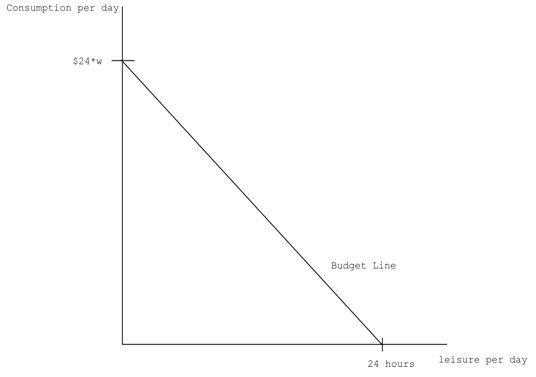
Suppose now that the government implements a progressive income tax. That is, the higher your total (not hourly) income, the higher the tax you pay on each additional dollar you earn. Which of the four graphs below could illustrate your budget line with this tax? (The dashed line is the original budget curve, provided for comparison.)
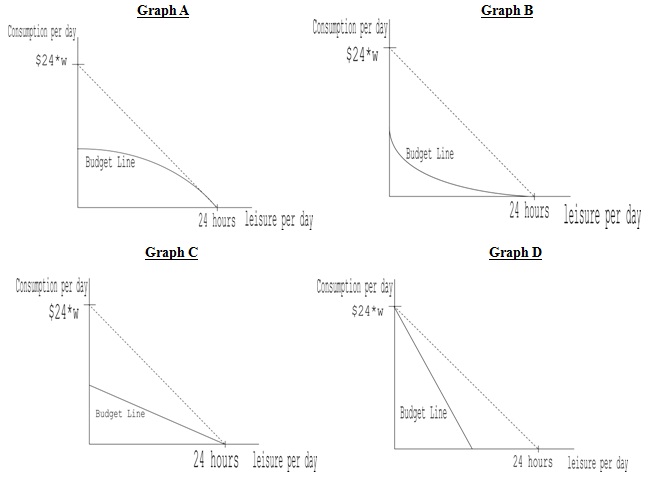
a) Graph A
b) Graph B
c) Graph C
d) Graph D
Question 32: Suppose Sally lives in a universe where Left Shoes and Right Shoes are sold separately, but are still perfect complements. The price of Right Shoes is R, and the price of Left Shoes is L1. Sally's income is W. Suppose now the price of Left Shoes decreases to L2. A graph of the Indifference Curves and Budget Lines is provided below for clarity.
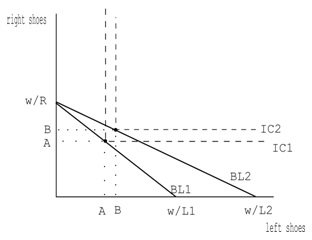
Notice, when the price of Left Shoes decreases, consumption of both Left and Right Shoes increases from A units to B units.
What can we say about the income and substitution effects on Left Shoes?
a. Both the Income and the Substitution effects are positive.
b. The Income effect is zero and the Substitution effect is positive.
c. The Income effect is positive and the Substitution effect is zero.
d. Both the Income and the Substitution effects are zero.
Use the following information to answer the next Two (2) questions.
Assume that the market for smoothies on Library Mall is perfectly competitive. Each smoothie cart on LibraryMall has the same total cost function curve and marginal cost curves. These cost curves are given by the following equations where q is the number of smoothies:
Total Cost Curve for Representative Smoothie Cart: TC = q3 + 2
Marginal Cost Curve for Representative Smoothie Cart: MC = 3q2
Question 33: The break-even price of a smoothie is ____ and the shut-down price of a smoothie is ____.
a) $1, $0
b) $1, $3
c) $3, $2
d) $3, $0
Question 34: Suppose now that the market demand for smoothies is given by the following equation where Q is the market quantity of smoothies and P is the price per smoothie:
Market Demand Curve: Q = 100 – 2P
How many smoothies are supplied when this market is in long run equilibrium? Assume that all of the above information is still true and that everything has been held constant.
a) 100 smoothies
b) 94 smoothies
c) 98 smoothies
d) 96 smoothies